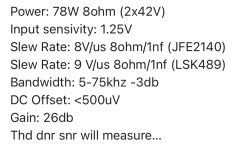Hey, did you find time to measure the THD+noise performance?
I only did the tests that I could do on a normal oscilloscope. I don't have a good sound card, so I ordered quantum asylum. All necessary performance measurements will be made and shared. The measurement data I can provide you right now are on the first page.
Attachments
Definitely you right! After a lot of LM3886 applications, i feel more performans and musical sound….Tda7293 is an excellent chip, far outperforms 3880 with a good layout.
My listening experiences, the analytical and cold sound of modulus, its weaker state than the dynamism we call torque, turned me off from listening to music... Among the applications I made with LM3886, I got the best sound with ne5532. For me, the LM3886 and the designs made with it were good on paper, but not good for me when listening. The jfet balanced input composite feedback tda7293 application is definitely more successful than its competitors in listening tests… measurements will be shared very soon…
Quantum asylum system is statistically reliable if you're measuring THD+noise > -113dB. For lower THD+noise the error becomes too high and obscures the results. For the fraction of the price I build analog measuring system (THD+noise < -135dB) using as a final step an oscilloscope with FFT.I only did the tests that I could do on a normal oscilloscope. I don't have a good sound card, so I ordered quantum asylum. All necessary performance measurements will be made and shared. The measurement data I can provide you right now are on the first page.
Just because an amplifier looks great on paper doesn't mean it sounds good. When I test modulus and my amplifier in the same room, same speakers, same dac etc., my amplifier is more successful than modulus. I think I made the right amp for myself.
You can use any scope with FFT and 8-bit resolution or more. The heavy lifting is done in the analog part. I'll start a new thread soon, describing the project.Which scope do you use for FFT?
12 Bit?
Gnd: sıgnal line, agnd power line… I always keep the signal gnd and power gnd separate and work in star chassis order and collect them at a single point.
Parallel and single versions have technically and cosmetically high technical audio grade PCB drawings…
Parallel and single versions have technically and cosmetically high technical audio grade PCB drawings…
Last edited:
Recently, my dear friend Sercan sent me a pair of Jfet buffered TDA7293 boards. I thank him.
I spent a few days assembling the cards. To be honest, I admit that I'm having a bit of a hard time since I haven't made DIY audio for a long time.
I could not install the low-noise regulator modules in 78xx/79xx format that him sent with it. Therefore, I supplied the +-15v supply of the amplifier externally with a LM317-337 board.
My first impressions:
The amplifier has very low noise and low distortion. It is impossible to hear any distortion in full audio band.
The details are clear and airy. The basses are satisfactory, but it is difficult to predict if a basshead will stasfy or not from the basses..
The trebles and especially the mids are quite clean. The stage is incredibly wide. In this way, especially the works containing vocals are seriously satisfactory.
Unlike many high-quality DIY amplifiers, the details are not distracting and in this sense, it is musical enough to be listened to for long periods of time without falling asleep.
As someone who usually listens to Latin, vocal jazz and Mediterranean music, I admit that I was impressed with the amplifier.
I couldn't measure the dynamics of the amplifier because I didn't have enough equipment. However, based on my ears and my ~40 years of DIY audio experience, I am sure it has a reasonable THD and noise level.
That's all my short review & listening impressions for now.
I wish you days with lots of music.
Last edited:
- Home
- Amplifiers
- Chip Amps
- TDA7293+JFE2140(LSK489)composite feedback amplifier

 One of the participants in this thread has been banned. Several forum rules were broken. Some posts have been removed.
One of the participants in this thread has been banned. Several forum rules were broken. Some posts have been removed.